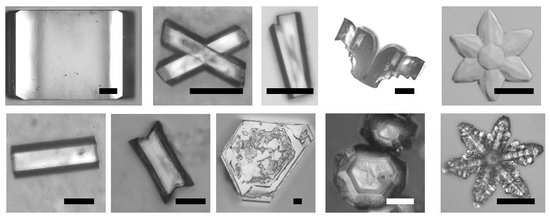Sodium flouorosilicate is an interesting material because its crystals show morphologies very similar to those of ice crystallizing in the atmosphere and its refractive index is very close to that of ice. Therefore it is possible to study the optical properties of cold clouds using these ice-analogues instead of real ice crystals [1-4]. Such experiments, important particularly for improving our understanding of climate change, have been conducted at University of Hertfordshire for some years [2-4] and they confirmed the usefulness of fluorosilicates as a cheaper and easier alternative to experiments involving direct use of ice crystals.
In this work we present results of an investigation of growth kinetics and morphology of sodium fluorosilicate crystals. The aim of this research is to understand the relation between growth conditions and crystal morphology and kinetics, which should provide indications on how to obtain a broad range of analogue crystal habits typical of ice crystals on the one hand, while maintaining uniform crystal size and shape populations on the other hand.
Three methods were used to grow sodium fluorosilicate crystals. In the first one supersaturation was obtained by controlled evaporation of the solute. Evaporation rates from 1 to 10 % of solute per minute were used. The sizes of most of the fluorosilicate crystals grown by this method were from 100 to 250 μm and the morphology was strongly dependent on the supersaturation (Fig. 1). At low supersaturations hexagonal columns, hexagonal plates and a variety of twins were the most frequently observed habits. At higher supersaturations stars, sectored stars and dendrites were observed. During the experiments the growth rate as a function of the evaporation rate and time was measured. In most of the experiments the growth rate was in the range of 10-40 nm/s. The experiments allowed us to construct a map (with the quantitative data) indicating which growth conditions are most appropriate for obtaining different morphologies
In the second method supersaturation was obtained by solution cooling. In these experiments the growth rate and supersaturation were precisely measured for hexagonal prisms and plates. These experiments allowed us to estimate the kinetics coefficient for the solution growth of sodium fluorosilicate.
Sodium fluorosilicate crystals were also grown in tetramethoxysilane (TMS) gel. In this case the crystals obtained were grater than those grown in solution - up to 1 mm in size. Two types of morphology were observed during gel growth: very well formed hexagonal crystals with additional high index faces and aggregates of small crystals
During the experiments we obtained many habits typical of ice crystals growing in the atmosphere (hexagonal columns, plates, stars or dendrites) and also some habits not common for ice crystals, such as “dog bones”. Unfortunately, some important morphologies existing for ice crystals are still absent. Thus the deeper understanding of mechanisms leading to obtaining different habits is still required. In the other work [5] we present results of theoretical analysis of growth habits for hexagonal plates and columns.
 Fig. 1. Examples from the gallery of sodium fluorosilicate crystals habits obtained during the experiments. Scale bare is 100 μm. Fig. 1. Examples from the gallery of sodium fluorosilicate crystals habits obtained during the experiments. Scale bare is 100 μm.
- A.J. Baran, On the scattering and absorption properties of cirrus cloud, J. Quantit. Spectr. Rad. Transf. 89 (2004) 17
- Z. Ulanowski, E. Hesse, P. H. Kaye, A. J. Baran, R. Chandrasekhar Scattering of light from atmospheric ice analogues. J. Quantit. Spectr. Rad. Transf. 79-80C (2003) 1091
- Z. Ulanowski, P. Connolly, M. Flynn, M. Gallagher, A.J.M. Clarke, E. Hesse, Using ice crystal analogues to validate cloud ice parameter retrievals from the CPI ice spectrometer data. 14th Int. Conf. Clouds Precipit., Bologna, pp.1175-1178 (2004)
- Z. Ulanowski, E. Hesse, P.H. Kaye, A.J. Baran, Light scattering by complex ice-analogue crystals. J. Quantit. Spectr. Rad. Transf. 100 (2006) 382
- J. Prywer, M.J. Krasiński, The analysis of growth habits of sodium fluorosilicate ice-analogues crystals grown from solution and gel. This conference
|